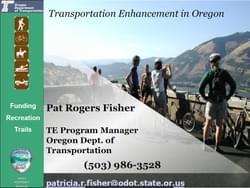




This presentation will discuss transportation funding programs that benefit trails and trail-related activities, focusing on Transportation Enhancement Activities and the Recreational Trails Program.
by Christopher Douwes, Community Planner, Federal Highway Administration, Patricia Fisher, Transportation Enhancement Program Manager, Oregon Department of Transportation, Rocky Houston, State Trails Coordinator, Oregon Parks and Recreation Department

Speakers: Christopher Douwes, Trails and Enhancement Program Manager, Federal Highway Administration, Patricia Fisher, Transportation Enhancement Program Manager, Oregon Department of Transportation, Rocky Houston, State Trails Coordinator, Oregon Parks and Recreation Department
This presentation will discuss transportation funding programs that benefit trails and trail-related activities, focusing on Transportation Enhancement Activities and the Recreational Trails Program. It will provide State-specific examples. The Federal Highway Administration’s Transportation Enhancement (TE) Activities and Recreational Trails Program (RTP) provide funds to develop transportation and recreation infrastructure. TE activities benefit the traveling public and help communities to increase transportation choices and access for pedestrians and bicyclists; and enhance the built and natural environment through scenic and historic highway programs, landscaping, historic preservation, and environmental mitigation. The RTP provides funds to the States to develop and maintain recreational trails and trail-related facilities. This presentation will explain these programs and offer suggestions on how to apply for funds.
posted Apr 17, 2024
This report summarizes guidance and best practices to create safer bicycle facilities and connect them into networks that allow more people to safely bike to more places within and throughout communities.
Making Transportation Planning Applicable in Tribal Communities Research Study: Final Report
posted Dec 20, 2023
The Federal Highway Administration’s (FHWA) Office of Tribal Transportation (OTT) planning staff have observed two challenges in Tribal transportation planning: (1) that existing planning analysis tools do not always align with Tribal community context and needs and (2) it is not always clear what benefits planning provides to transportation project selection and delivery in Tribal communities.
Tribal Development of Trails and Other Dedicated Pedestrian and Bicycle Infrastructure
posted Dec 19, 2023
This white paper provides information and resources for Tribes, Tribal trails and active transportation advocates, and agencies that may partner with Tribes on trail projects including Federal and State agencies, MPOs, county and local governments, and community organizations.
Rails to Trails Conservancy's TrailNation™ Playbook
posted Dec 13, 2023
Rails to Trails Conservancy's TrailNation™ Playbook brings the decades of experience building trail networks across the country to a resource of case studies, best practices and tools for trail network development on a local and national level.
918 views • posted 02/19/2018